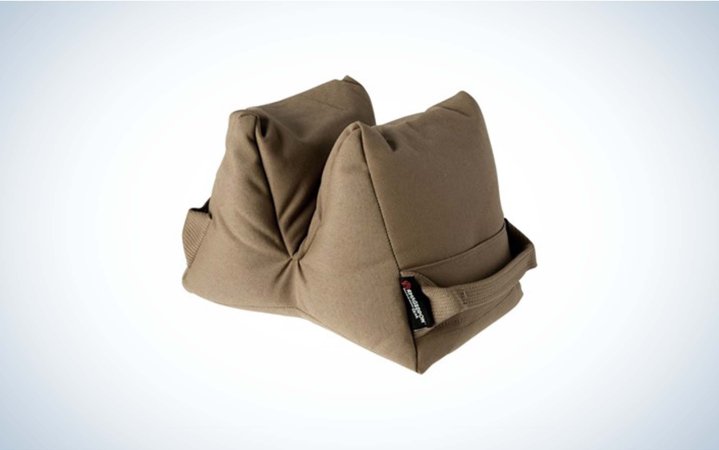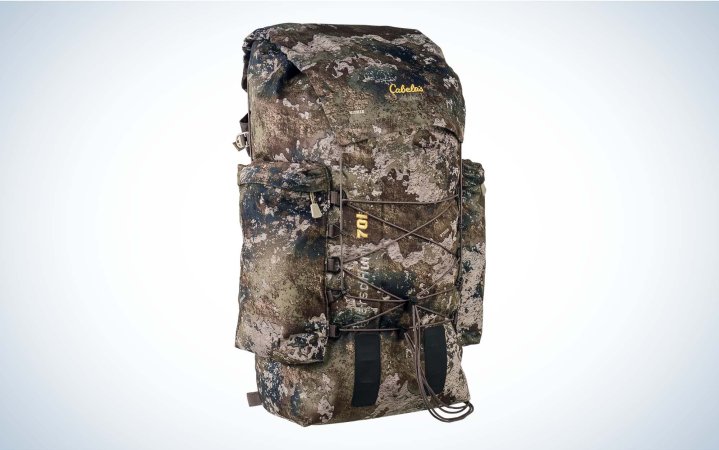We may earn revenue from the products available on this page and participate in affiliate programs. Learn More ›
Shooting off a bench is great for checking your rifle’s zero and getting a handle on its precision, but it has nothing to do with hunting rifle accuracy and making accurate shots on game in the field. After all, there are no cement benches in the woods. Whether you’re still-hunting through timber, stalking along a river bottom, sitting in a treestand over an ag field, glassing an alpine meadow, or perched high on a mountain ridgeline, you’re going to shoot better if you have some kind of aid that you know how to use. Here are six of the best field-expedient shooting aids you can use. I’ve relied on all of these over the years to make cleaner, more ethical shots on game.

Shooting Bag: The Best Rifle Accuracy Aid
A properly constructed shooting bag with lightweight fill is the most useful of all marksmanship aids. If I were allowed only one extra support, this would be it. Old-school sandbags are nothing new, and it wasn’t uncommon for shooters to make their own squeeze bags from socks filled with rice or plastic beads. But those earlier iterations lacked the capabilities of today’s bags. Don’t confuse the two.
There are several good models to choose from, but my favorites are the waxed cotton Game Changers from Armageddon Gear. When filled with a premium lightweight fill, like Git-Lite, these bags become truly remarkable tools.
How to Shoot Off a Bag
You can employ the bags any number of ways, but when shooting off rocks, stumps, branches or other surfaces they work best when you lay them lengthwise under the stock of your rifle in front of the triggerguard. That position maximizes the contact between the stock and bag, improving stability, and positions the rifle at its natural balance point.
With a bit of downward pressure on the scope with your non-shooting hand, the rifle can become incredibly steady. I use this technique in competition and in the field.
Why is this specific combination of bag material—waxed cotton—and fill—Git-Lite—preferable to homemade solutions? The waxed cotton grips the stock and the shooting surface better than Cordura and other materials, which tend to be slippery. And the fill, unlike beads you might find in a hobby store, takes a set when put under pressure so that it behaves like sand, but at a fraction of the weight. Regular plastic beads will slip and slosh around and aren’t nearly as capable. It’s little surprise that every USSOCOM unit has taken to using these bags in the field.
Bipod: The Essential Hunting Rifle Accuracy Accessory
The biggest tradeoff with bipods is between size and portability. Shorter legs do better at keeping a rifle’s weight from skyrocketing and prevent its balance from becoming too muzzle-heavy, but they’re limited in terms of elevating a barrel above the ground. Longer legs can position the bore above vegetation for a clear shot but can make carrying and handling the rifle awkward. There is also a direct correlation between the ability of a bipod to create a steady shot under a variety of circumstances and the bipod’s weight. The most stable bipods tend to be the heaviest.
This is to say there’s no one-size-fits-all solution. The specific type of bipod that will work best for you depends on the terrain you hunt and the distance you intend to shoot. For rifles with a swivel stud on the fore-end, the Harris bipod is still tough to beat. They are fairly light, durable and don’t cost a pile of money. There are cheaper Harris knock-offs available, but I’ve found many of them to be poorly constructed. Get a model that swivels so you can get level on uneven terrain. Legs that extend from 9 to 13 inches are the most common and are a good choice if you can shoot off rocks or otherwise get above grass and brush. Otherwise, look at the models that have legs that go from 12 to 25 inches, which are suitable for taking sitting shots.
If your rifle has a section of Picatinny rail on the fore-end you have a lot of other options to explore. MDT makes some excellent (and expensive) bipods for competitive rifle shooters but recently has introduce the GRND-POD, which incorporates many design elements of their flagship bipods at a more affordable price. The legs quickly adapt to a variety of terrain and the bipod has 40 degrees of cant on tap to level the scope’s crosshairs.
Another great hunting bipod is the Atlas V8 series from B&T Industries. This is another premium product with easy-to-adjust legs that will work on uneven ground while providing excellent stability.
Some bipods come with the ability to pivot for shots on moving targets. Avoid these. Even shooters who deal with moving targets in competition and elsewhere don’t care for this feature. You don’t really need it, the pivot system adds weight, and under recoil the legs can pivot out of position decreasing accuracy.
How to Shoot with a Bipod
When it comes to shooting with a bipod, the best technique is to get square behind the rifle so that your shoulders make a “T” with respect to the rifle. Apply a bit of forward pressure on the recoil pad to take up slack in the bipod’s legs. You’ll hear this referred to as loading the bipod. The amount of pressure to exert can vary, but a good guideline is to picture the force it would take to pin a hardcover book between your recoil pad and shoulder without having the book slip to the ground.

Shooting Sticks: The Most Basic Rifle Accuracy Aid
A pair of crossed sticks is as basic as it gets, but this shooting aid is also very effective. The sticks can be as simple as two lengths cut from saplings, a pair of trekking poles crossed together, or one of the collapsible versions that you can stow in your pack or on your belt. Any version will improve your hunting rifle accuracy.
How Use Shooting Sticks
No matter which you use, the notion is the same. The sticks form a notch where you rest your rifle’s fore-end. The barrel’s height adjusts by moving the feet of the sticks closer together or farther apart as needed.
If the sticks are loose, you’ll need to hold them together with your lead hand, but if they are joined, you can use the non-shooting hand to stabilize the stock in your shoulder.
Shooting sticks are especially effective from the sitting position, and even more so if the shot is downhill. I’ve made some long pokes with total confidence with my rifle braced on shooting sticks and it doesn’t take a lot of practice to figure out how to employ them.
Backpack: The Marksmanship Aid That’s Always With You
Laying a backpack on the ground and resting a rifle across it is a tried-and-true technique. While it doesn’t provide the stability of these other purpose-built shooting aids, it does have the benefit of always being available.
To make a better shot, it helps to have the pack filled to an adequate degree. Sometimes that means rearranging the pack’s contents to stuff the bottom portion of the bag or even taking off a jacket and putting it in the pack for sufficient fill.
How to Shoot Off a Backpack
While going prone over a pack is an obvious way to shoot, you can also stand the pack upright and pinch it between your legs to act as a support for a sitting shot. Some pack designs lend themselves to this technique better than others. If your pack can stand upright on its own and has some type of internal frame, you can get a surprisingly solid rest.
A little bit of practice at the range or dry-firing at home will go a long way to helping you use this rifle accuracy technique effectively in the heat of the moment.

Tripod: The High-Tech Rifle Accuracy Aid
Technical Western hunters who spend a lot of time glassing are learning to use their tripods as a rock-solid shooting support. The inspiration for this comes right from practical precision rifle competitions—such as the NRL Hunter series, Riflemen’s Team Challenge series, and PRS—where shooting off tripods is a bread-and-butter technique.
Let’s talk about the downsides first. One, not every tripod is up to the task. If you have a spotting scope with a flimsy tripod, this shooting method won’t be very helpful. And the tripods that are capable tend to be expensive and add weight to your kit. Those aren’t insignificant considerations. However, if you do invest in a quality carbon-fiber tripod that you can shoot off, you’ll also have a better platform to glass from that will be less prone to vibrating in the wind, which is a boon.
The next issue is connecting your rifle to the tripod. You can get cradles that pinch your stock, such as the HOG saddle or BOG Pod Deathgrip, and these work fairly well. Or you can add a Picatinny or ARCA rail adapter to your rifle and lock it directly into a compatible tripod ballhead. One of the best lightweight and packable tripods for this is the Two Vets No Name.
How to Shoot Off a Tripod
While a section of Pic rail at the front end of your stock can be used to clip into a tripod, you’ll get your best results if the attachment point is closer to the rifle’s balance point in front of the trigger guard. The rifle will be easier to manipulate and steadier.
A next-level option is to use a quick-release ball head that lets you swap your spotter for a tac-table. Then, you place your Game Changer shooting bag on the table and your rifle on the bag. Good quality tac tables are available from Victor Company, Gray Ops CNC, and Bison Tactical.

Shooting Sling: The Old-School Marksmanship Aid
This is a classic, old-school shooting aid, and its use is basically a lost art at this point. Now chances are the thing you have dangling off your rifle isn’t a shooting sling. Technically, it is a carrying strap. A shooting sling is a marksmanship aid. It’s ability to help you comfortably haul your hunting rifle around is a secondary concern.
How to Use a Shooting Sling
Shooting slings come in different configurations, but they all work with the same goal in mind. By weaving your lead arm through the sling you can lock the recoil pad in your shoulder while making a solid connection between your support (lead) hand and the rifle’s fore-end.
To get this solid connection, the sling must be properly adjusted to your body proportions and (to a lesser degree) the shooting position being employed. Most, but not all, shooting slings have loop that is cinched tight around the biceps of the lead arm.
A shooting sling can be used from off-hand, kneeling, sitting and prone positions and when used correctly is a great way to steady your crosshairs and improve your hunting rifle accuracy.
Read Next: How Accurate Is Your Hunting Rifle?
The slings designed for this work aren’t as comfortable as standard carrying strap, but the tradeoff in stability can be worth it. The M1907 sling is the OG version, but you can find modern iterations from Murry Custom Leather, TAB Gear, Rifles Only, and Short Action Precision.






